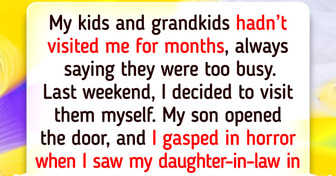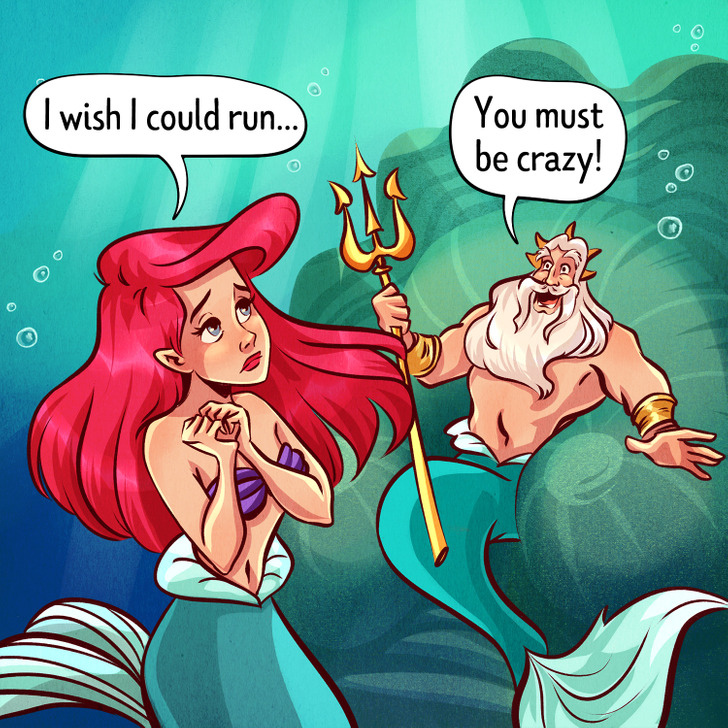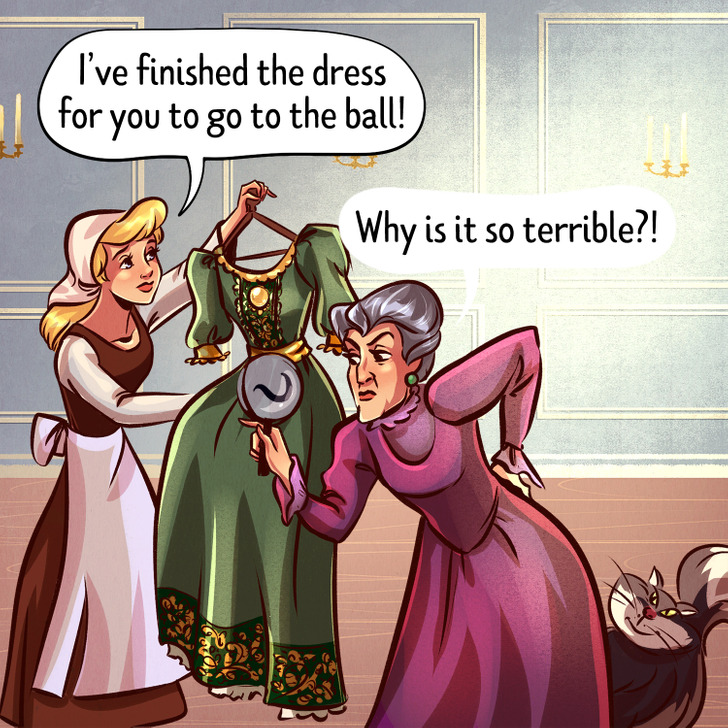Noooooooooooooooo!!!!!!!
10 Toxic Parents Disguised in Cartoon Characters That Could Send Any Kid to a Psychotherapist
Being a parent is perhaps one of the most difficult jobs in the world, and parenting in fairy tales is no exception. No one is guaranteed to not make mistakes, and there is no single rule that clearly outlines how to act in a certain situation. Nevertheless, some recommendations still exist.
Bright Side put a list together of the most toxic parents from fairy tales and, using them as examples, analyzed behavior that definitely shouldn’t be repeated if you want to build a good relationship with a child.
Making fun of a child’s dreams (The Little Mermaid)
Ariel had a dream — she wanted to go on land and walk on the ground. However, instead of supporting his daughter, her father only made fun of this idea, neglecting it by all means. We all remember the tragic end it leads to.
It’s absolutely natural for a kid to dream. However, many parents treat it like nonsense or another fantasy that shouldn’t be paid attention to. Such indifference can not only reduce a child’s trust in adults, but it can also make them less self-confident.
What to do? Ariel’s father was supposed to sit and talk about everything with his daughter. He could warn her about possible dangers and think out an action plan — a more reliable idea than using dubious magic. In general, this strategy works well not only with kids from fairy tales, but with kids in real life too.
Hyper-focused care (Thumbelina)
The mother of the toad from Thumbelina is so used to caring for her dear son that she even chose a bride for him when he became an adult. He, in his turn, turned into a helpless adult who can’t do anything for himself and who fails to keep his bride.
In real life, kids that grow up with such hyper-focused care become adults, but they oftentimes fail to become independent. Later it affects the quality of their personal life, their self-esteem, and the life of their parents.
What to do? Toad’s mother should have let her son fail. If he wanted to get married, he should’ve gone and searched for a future wife himself. After all, perhaps he wanted to get married because he was bored. Teacher Jessica Lahey even wrote a book on this topic — The Gift of Failure, which says that parents shouldn’t be afraid to let their kids make mistakes. Failures help them learn and find ways to reach their goals.
Devaluation (Cinderella)
The relationship between the stepmother and Cinderella is a perfect illustration of devaluation. No matter what her hard-working stepdaughter does, the stepmother was always finding something to complain about. Her daughters see the way their mother treats their stepsister, and perhaps it’s this thing that contributes to them becoming narcissists.
Of course, kids are unlikely to do something that will truly impress their parents because they don’t have enough knowledge and skill. Things that seem easy for adults can be a big leap and a big achievement for kids. We should always remember that.
What to do? If the stepmother was at least showing gratitude and maybe praising Cinderella, without diminishing her personality, the fairy tale would likely have a different ending. For example, a happy family would’ve moved to the castle together. As for real life, of course, we don’t have to happily clap our hands every time our kids tie their shoelaces on their own, but paying attention to it and praising the kid are important things to do.
Ignoring a kid’s fears (Hansel and Gretel)
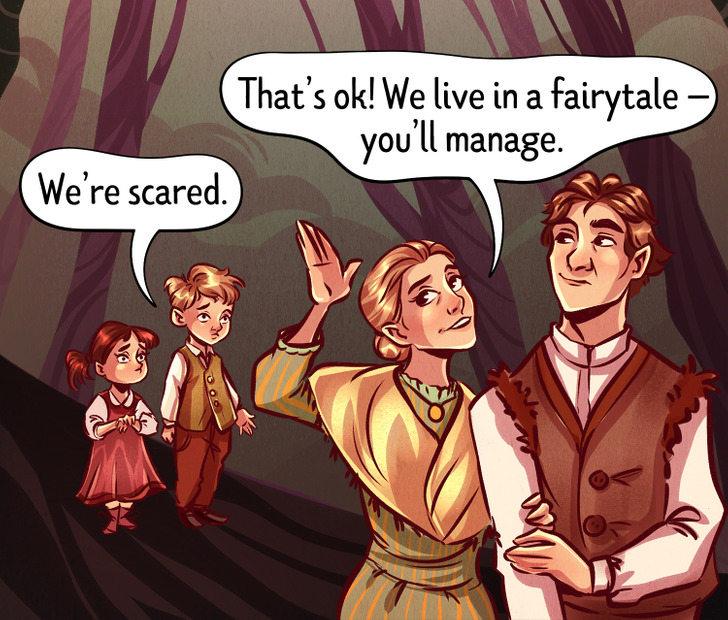
The behavior of Hansel and Gretel’s parents can be considered ready-made instructions on how to act if you want to lose your kid. If you are pursuing the opposite goal — to save and establish harmonious relations with your offspring, then one of the first things to do is to listen to children’s fears.
Perhaps they might seem silly for adults, but a kid’s psyche is arranged differently, and we should take that into account. In order not to let your kids find themselves in an enchanted gingerbread house or at a psychotherapist session working over childhood traumas.
What to do? It’s simple here: don’t leave your kids alone in the forest, and don’t ignore their fears.
Disrespect for personal boundaries (King Thrushbeard)
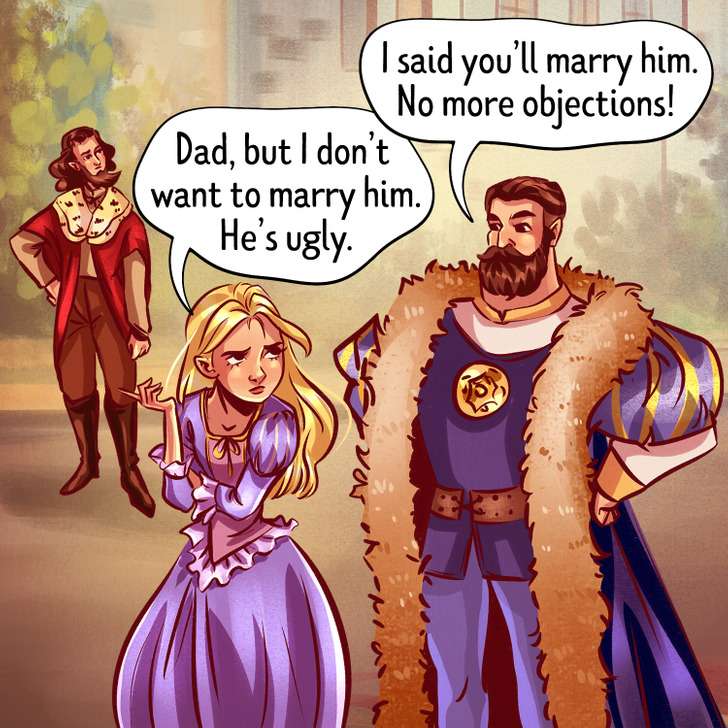
Many fairy tale kings tend to disrespect the personal boundaries of their daughters. Princesses are given in marriage against their will to strengthen the power of the kingdom, for “educational” purposes, or even for no good reason. Thankfully, in fairy tales, everything is usually resolved safely by some miracle.
But we are not living in a fairy tale, and neglecting a kid’s opinion most often has negative consequences. Children can become estranged or never learn to set and defend their boundaries and interests, suffering very much from this in adulthood.
What to do? To remember that a king is, first of all, a father and that the daughter is a mature person with her own opinion (taking into account that she is about to get married) that should be listened to. And this should be done not just with fairy tale princesses.
Guilt trips (The Gingerbread Man)
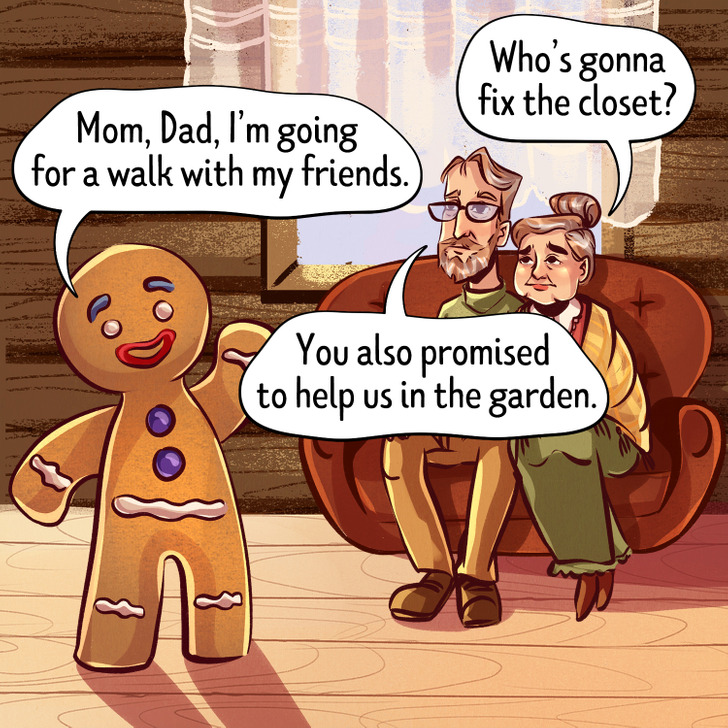
According to some researchers, the fairy tale The Gingerbread Man is a story about growing up. When the Gingerbread man leaves his parents to explore the big world, they feel bad, begging and asking him to come back. But it’s unlikely that this behavior happens just because they want to keep him safe. After all, his parents baked him for themselves, and he left without their permission.
Of course, parents don’t run after their kids in real life, but they can appeal to their feeling of guilt, by, for example, asking them to help with household chores. However, in this case, it looks more like manipulation rather than a relationship between an adult and a mature personality. Usually, this behavior turns the kid off and makes them more reserved.
What to do? The parents should have talked to the Gingerbread Man openly and honestly from the very beginning and shared the fact that they count on him and that they, his elderly parents, need help. Many of us lack sincere talks like this in real life as well.
Shifting responsibility from the child to others (Pinocchio)
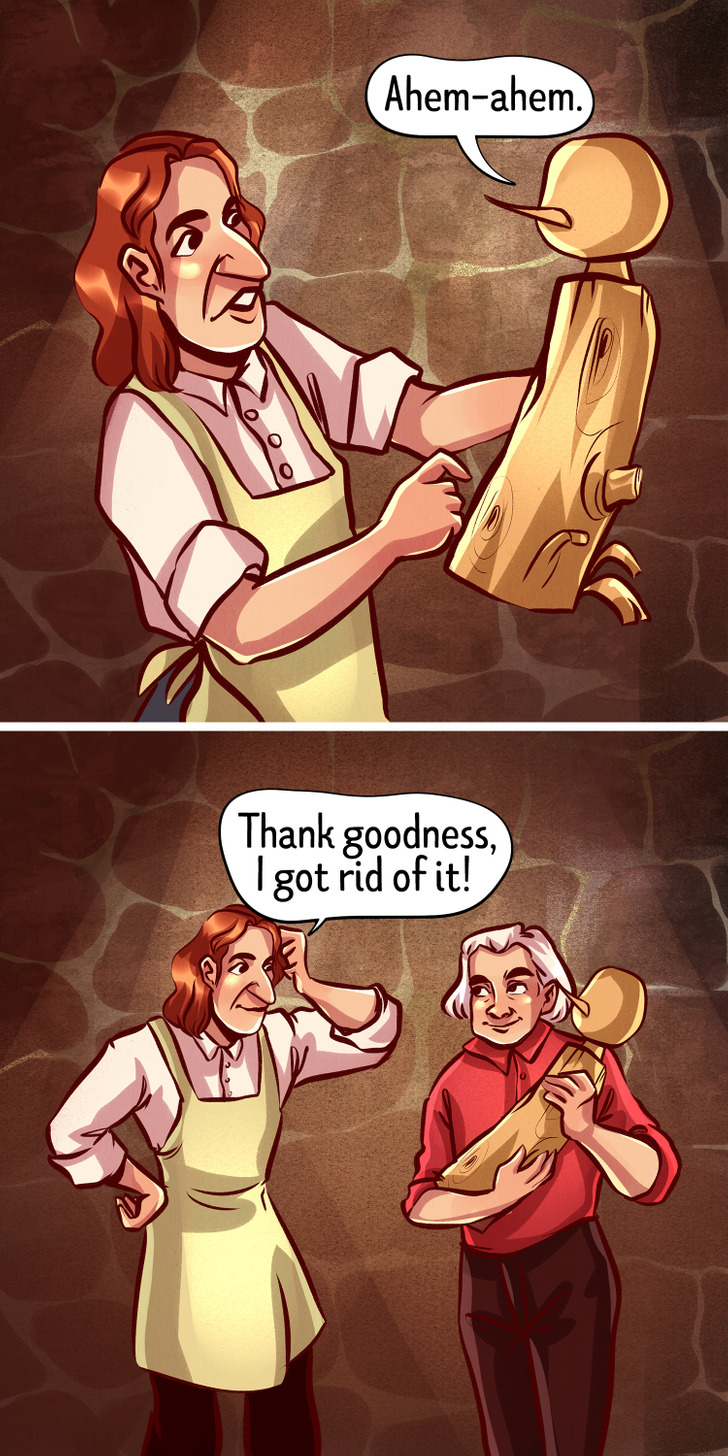
In the original fairy tale, an old carpenter suddenly finds out that a log he was working on can talk. Feeling scared, he gives away the piece of wood to his friend, asking him to get rid of this bizarre object. Later, his friend makes a live doll out of the log.
In real life, the burden of parental responsibility carries so much weight and is so scary that it is easier to either give it up altogether or shift the blame to someone else. For example, blame the teachers and the school for the poor education of the child.
What to do? We are all scared, and we all make mistakes, and the process of raising kids is no exception. Perfect parents don’t exist, and neither do perfect kids. Don’t panic if something goes wrong. It’s better to just stay calm and analyze the situation — perhaps that’s not something bizarre, but something truly magical?
Shifting responsibility to the kid (Little Red Riding Hood)
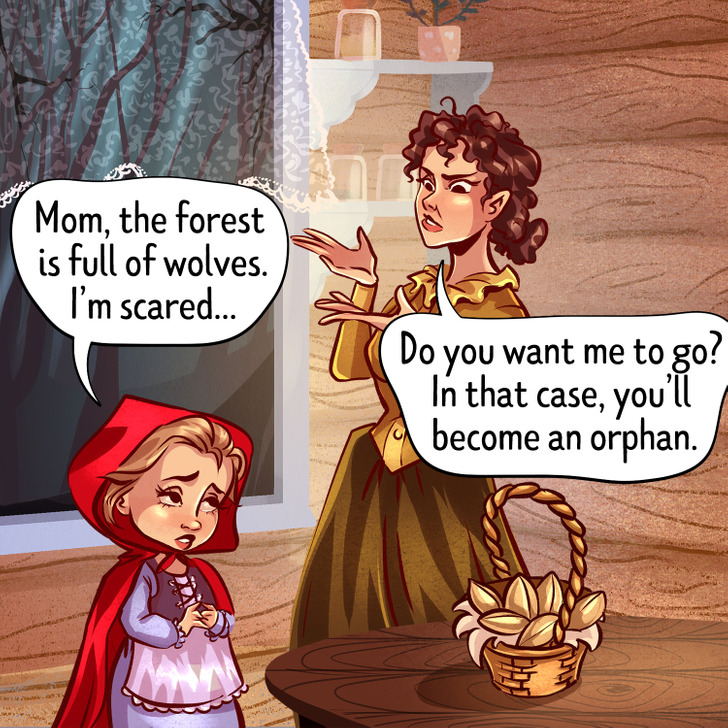
If we forget that this is a fairy tale and look at the story of Little Red Riding Hood through the eyes of an adult, some things will truly surprise you. How could she send her young daughter into the forest alone? Wasn’t she worried about her? Or maybe she didn’t want to go herself and see the granny?
In real life, some parents can also put responsibilities that don’t match their kids’ age onto their shoulders. It makes them grow up too early, when the kids are not ready. This approach can not only lead to dangerous situations that a kid can’t handle yet, but also to psychological issues.
What to do? Sharing house chores is a good idea. But sending your daughter somewhere far away, alone, is definitely not. After all, the mother could’ve gone and seen the granny together with her daughter and spent some quality time with them. In real life, some parents should also reconsider the number of duties they put on their kids, who are not adults yet.
Parental tyranny (The Swineherd)
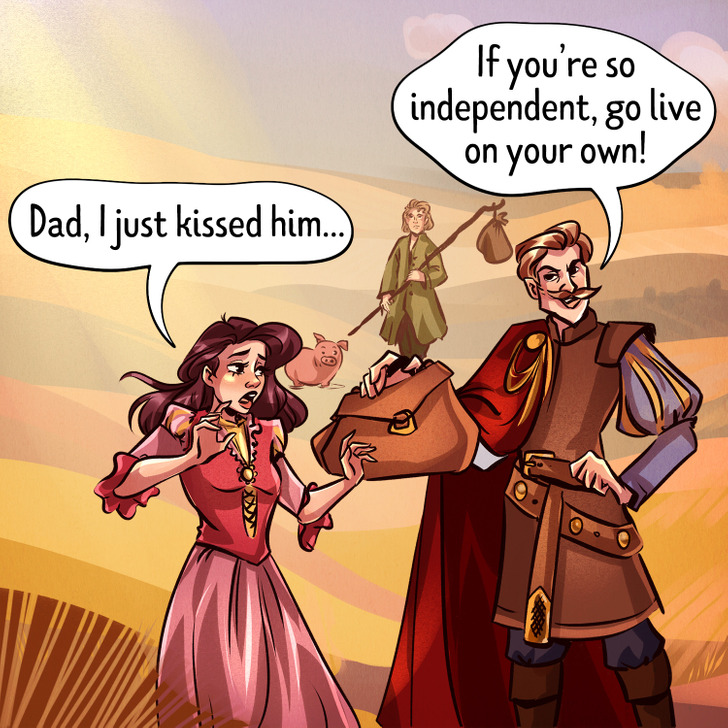
Again, we have a king/father who always knows what is best for his kid. The princess got slightly carried away and kissed the swineherd, who by the way wasn’t behaving in an honest and noble way, and the king got furious and drove his daughter out of the house.
In real life, these tough and powerful parents act like tyrants who no one can go against, especially if it’s a small and completely dependent creature.
What to do? Understand and forgive. Perhaps, discuss this action with your child.
Ignoring the kid (Karlsson-on-the-Roof)
Child neglect sometimes turns out to be more dangerous and traumatic for the child’s psyche than, for example, excessive control or severity. Thus, the boy got on the roof and scared his parents to death. At the same time, he was just telling them about his new friend, but they were not listening to him.
This example is actually not that distant from real life. If you don’t pay attention to your kid and are always busy with something else, telling them you don’t have time for them, one day you might have to get them out of some trouble too.
What to do? All is simple: these parents should’ve paid attention to their kid and learned more about his new friend. It’s actually much simpler in real life — listen to your kids more often, especially when they are trying to share something with you. You can start a tradition and discuss the news and new thoughts during a family dinner each evening.
What examples of toxic behavior do you know of?
Comments
Someone didn't really read any of the stories because they completely missed the point.
Related Reads
10+ Phrases That Reveal People Who Had a Not-So-Simple Childhood
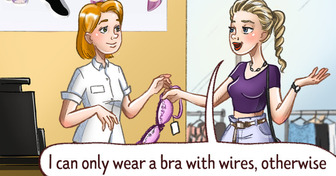
A Taiwanese Artist Creates Short Stories With Unexpected Plot Twists
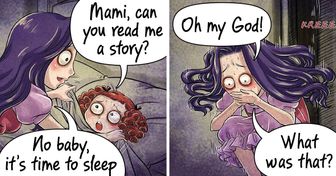
15 Double-Standards That Can Even Ruin Relationships in Perfect Families
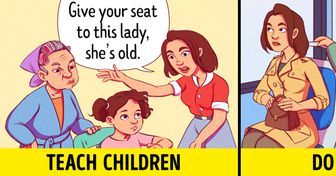
My Boyfriend’s Family Refused to Take Me on a Trip, and I Found the Perfect Revenge
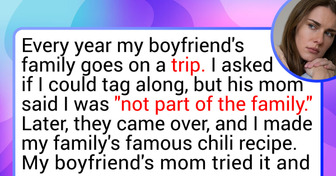
16 Tweets From People That Haven’t Quite Gotten Over Their Exes

People Shared 15+ Tales From Work That Are Either Witty, Hilarious, or Downright Infuriating
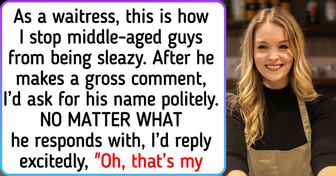
15+ Bright Side Readers Shared Why They Still Can’t Forgive Their Parents
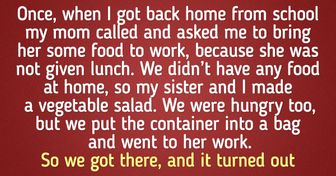
We Compared How 16 Celebrities Looked at the Beginning of Their Career and Today

16 People Who Blossomed Into Beautiful Swans After Their Teenage Years Had Passed
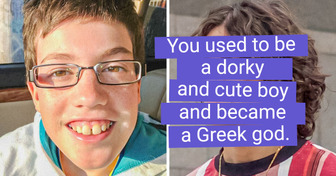
I Refused to Split My Son’s Inheritance With My Other Son
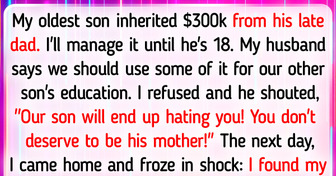
12 True Events That Sent Shivers Down Our Spines
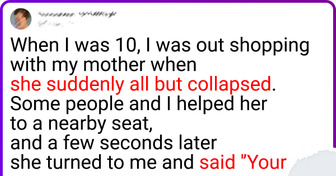
12 Stories That Prove Grandparents Are the Heart and Soul of Family
